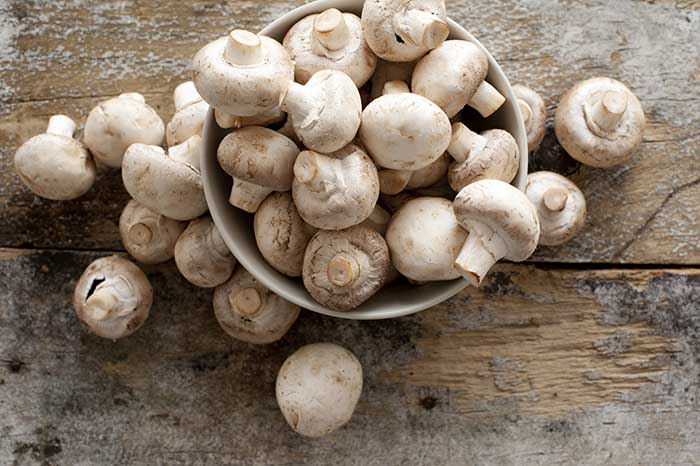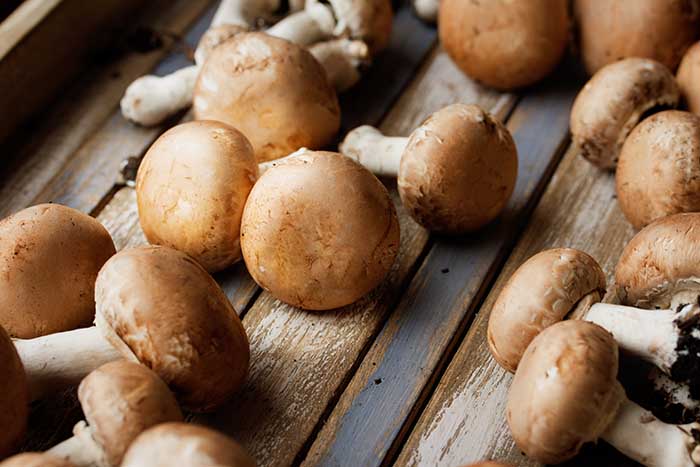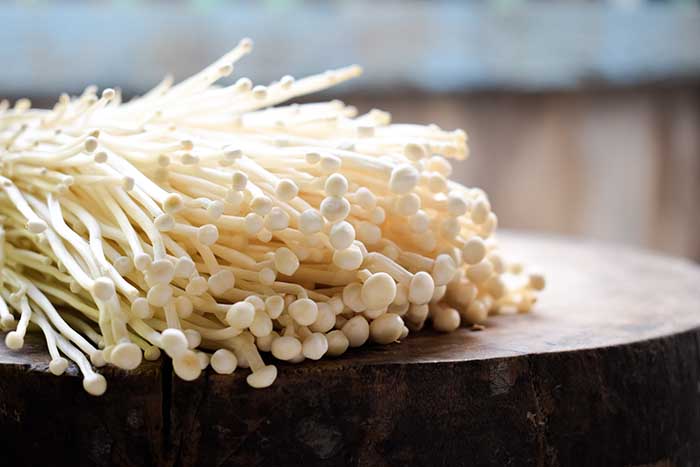The best types of mushroom for cooking, from shiitake to portobello. Master flavors and cooking techniques for our favorite culinary fungi.

There are countless species of mushrooms that you can find in your local supermarket, farmer’s market, or even forest if you are inclined to forage. Each one of these unique fungi has a special flavor profile, appearance, and usage. Here is your guide to the most common types of mushrooms used in cooking and eating.
White Button

White button mushrooms are the most common type of mushrooms found in supermarkets and American cuisine. You can tell them apart from other mushrooms thanks to their small size and distinct button shape. They are either white or with a brown tinge.
White button mushrooms are the same variety as cremini and portobello mushrooms, just picked earlier. They have a similar flavor profile but are much milder. White button mushrooms are known for their mild taste, although it becomes a little bit more robust when sauteed or grilled.
White button mushrooms are used in many different dishes because of their mild flavor and constant presence. Add them to risotto for an earthy rice dish, or cook them with some heavy cream for a decadent pasta sauce.
White button mushrooms are also excellent when they are raw. That is why they are commonly used as pizza toppings. You can also slice them up and add them to salads.
Shiitake

Shiitake mushrooms, also known as black forest or black mushrooms, are one of the most common East Asian varieties of mushrooms. Nowadays, many shiitake mushrooms that you find in supermarkets are cultivated instead of foraged, but that does not detract from their woodsy flavor.
Shiitake mushrooms are light brown. Their stems are very slender but inedible. They have a woodsy, savory flavor that some people compare to meat. If you’re looking for a more intense mushroom flavor, you can get dried varieties at specialty supermarkets.
Shiitake mushrooms’ East Asian origins mean they’re most commonly found in classic Chinese and Japanese cuisine. They provide a rich and buttery flavor to vegetable dishes, making them a great plant-based meat alternative. They feature prominently in vegan ramen recipes, providing substance and texture that other vegetables often can’t. You also add them to udon or any stir fry noodle dish for a rich burst of flavor.
Shiitakes are often used as meat replacements (for example, when making mushroom bacon) or when making sauces because of their meaty flavor. Use them to add a depth of flavor and thickness to gravy.
Cremini

If you think cremini mushrooms taste like a more mature version of white button mushrooms, that is because they are. Cremini mushrooms are the same species as white button mushrooms, just at the second growth stage.
Unlike white button mushrooms, cremini mushrooms have a light brown cap. They are a little larger and have a more robust, savory flavor.
You can use cremini mushrooms in the same dishes that you would use white button mushrooms because of their similarities. They work well in cooked dishes such as risotto and pasta, sliced on top of a pizza, or even raw in salads.
While white button mushrooms are a good choice for someone getting used to mushrooms, creminis are more robust and an excellent choice for true mushroom lovers.
Portobello

Portobello mushrooms are the final evolution of white button and cremini mushrooms. They have been allowed to grow to full maturity.
Portobello mushrooms are much larger than cremini or white button mushrooms. The biggest specimens can be as wide as a person’s hand. They are also darker in color, with a rich brown cap. Finally, portobello mushrooms have a much more intense flavor than cremini or white button mushrooms with plenty of savory, meaty notes.
You can use portobello mushrooms in the same way that you would use cremini or white button varieties. They add robust flavors to pizzas, salads, pasta, and risottos.
However, their large size means that portobellos are more versatile than other mushroom varieties. Many people like to grill them to replace burger buns or patties. You can stuff portobello caps with cheese, bacon, vegetables, or any filling of your choice.
Due to their strong savory flavor, portobello mushrooms often get used as meat replacements in vegetarian or vegan cooking.
Enoki

Enoki mushrooms are another common Japanese mushroom variety. They are also known as the lily mushroom.
Enoki mushrooms are different from any other mushroom in their appearance. They are thin mushroom strands with small round caps that often grow and are sold in bunches. Some people think that their delicate stalks resemble string cheese! You can buy enoki mushrooms fresh or in cans, just be sure that they are fresh and white instead of slimy and brown.
Enoki mushrooms have a delicate, slightly savory texture. They add flavor to dishes without overwhelming them. Another unique aspect of these mushrooms is their texture. Enoki mushroom stems are crunchy, particularly when they are served raw.
Cooks most often use enoki mushrooms in soup, ramen, or other broth-heavy dishes. Just add them to your dish right before serving for extra flavor and texture that will bloom as the mushrooms cook in the broth. You can also add them to salads for a little texture.
Oyster

Oyster mushrooms have a distinct appearance compared to their fellow fungi. They have very short stems. Instead of the typical separate stem-and-cap mushrooms, oyster mushrooms grow together in clusters that form funky organic shapes.
Oyster mushrooms are a common meat replacement in vegan cuisine due to their robust pull-apart texture. Fry them to replace meat in tacos, stir-fries, and other dishes, or just saute them as a delicious side dish in their own right.
Oyster mushrooms are usually pale yellow, off-white, or gray. They have a stringy texture and pull apart easily. Their flavor is mildly savory, but they have a complex aftertaste that some people compare to black licorice or even seafood.
Oyster mushrooms cook evenly thanks to their texture, which is why they make an excellent addition to stir-fries and risottos.
Porcini

Porcini mushrooms are similar to Portobello mushrooms. They are both rich brown and are common in Italian cuisine, although porcinis are also popular in much of Central Europe.
However, porcini mushrooms tend to be smaller than portobello mushrooms. They also have a distinct nutty flavor that adds a bit more depth of flavor to dishes.
Fresh porcini mushrooms can be hard to find in the United States. They only pop up in farmer’s markets in late summer and early fall and tend to be pricier than other mushroom varieties. However, you can find dried or even pickled porcinis. To cook with dried porcinis, just let them steep in warm water for 20 to 30 minutes, then use that water as a broth.
Porcini mushrooms are excellent additions to risotto or pasta sauce. Dried porcinis make excellent stock using the rehydrating method described above. Porcinis are flavorful enough that just sauteeing them in butter makes an excellent side dish.
Maitake

Just like oyster mushrooms, maitake mushrooms tend to grow in clusters. They look like round, feathered birds, which is why another name for this mushroom is “hen of the woods.” Maitake mushrooms grow in North America and East Asia, where it is very popular.
Maitake mushrooms have small, brown caps that are clustered together like bird feathers. They have a strong taste that some people have even said is spicy like pepper. You should not serve maitake raw.
Maitake mushrooms are excellent additions to East Asian recipes. For example, add them to a stir-fry for a burst of earthy, peppery flavor, or toss them in soba noodles for a quick, robust sauce. You can also saute the mushrooms first then add them to ramen, pizza, or even galettes.
Chanterelle

There is a reason why mushroom foragers go wild for chanterelles when they are in season. These delicate fungi can only be found in the wild, so mushroom lovers can only enjoy their elevated flavors when they are in season.
Chanterelles can come in bright orange and yellow varieties or plain white. They are shaped like trumpets, with long, delicate stems that fan out into the crown. There are several species of chanterelles, each with its own flavor profiles. Most have a delicate texture with simple peppery, earthy notes.
Chanterelles are so delicate and delicious that they only need a light hand when preparing them. Saute them in oil or butter then serve them on their own as a side dish. Or, you can fold them into omelets, pasta sauces, and even cream soups.
Morel

Morel mushrooms are prized by high-end chefs and amateur gourmands alike. They have a distinct appearance thanks to their elongated cap. They have a short white stem and brown cap with a mottled honeycomb pattern.
Like chanterelles, morels can’t be grown on farms so foragers the world over hunt for these prize fungi in forests. They are particularly prized in French cuisine thanks to their potent savory flavor. Their texture is also distinct thanks to a little hint of chewiness.
Morels do not need much to taste great. Just saute them in butter to enhance their natural flavors. Then, you can use them to create a delicate sauce for meat dishes or to flavor soups.
With so many mushroom varieties out there, you are bound to find the perfect type for your dish and taste preferences.



